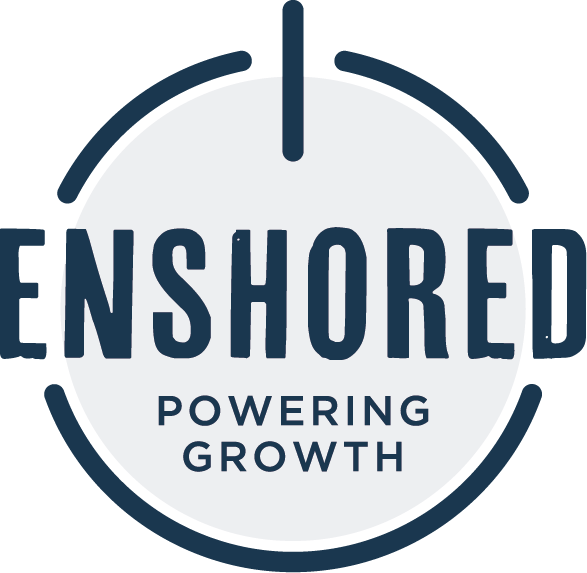Taking too long? Close loading screen.


Outsourcing customer service involves analyzing costs, service quality, and operational efficiency to determine its ROI. Positive ROI indicates cost savings, improved customer satisfaction, and business growth, making it a strategic move for competitive advantage. Here’s how.
Anxious about customer service costs? Wondering how to scale support without breaking the bank? In this post, we’ll uncover:
Outsourcing customer service can significantly impact your bottom line, but it’s crucial to measure its Return on Investment (ROI) accurately. Here at Enshored, we’re dedicated to demystifying this process, guiding you through cost comparison, quality metrics, and efficiency evaluations to make an informed decision.
When we talk about outsourcing customer service, it’s crucial to understand what ROI, or Return on Investment, really means for us and our clients. Let’s dive into what ROI is, why it matters, and the key components to look out for.
ROI in customer service outsourcing is a way to measure the efficiency of an investment. It helps us understand how much value the outsourced services bring in comparison to the cost. Simply put, if the value or benefits we receive from outsourcing customer service are greater than the cost, the ROI is positive.
A strong ROI from customer service outsourcing means we’re not just saving money but also enhancing customer satisfaction and business growth. Here’s why it’s critical:
Understanding ROI helps us make informed decisions about our customer service strategies.
Several factors contribute to the ROI when outsourcing customer service. It’s not just about cutting costs – it’s also about the value added in various forms. Here are the essential components:
By paying attention to these components, we can ensure that outsourcing customer service delivers a strong return on investment, aligning with our goals of cost-efficiency, customer satisfaction, and overall business growth.
Before diving into the world of outsourcing customer service, it’s crucial to assess a few key areas. Doing this groundwork will ensure you’re making an informed decision that will benefit your business in the long run.
Every business is unique, and so are its customer service requirements. Identifying what your specific needs are is the first step toward making an informed outsourcing decision. Consider the following:
Understanding these aspects will help you outline the scope of services you need to outsource effectively.
Budget is a significant factor in any business decision, and outsourcing is no exception. To make a sound decision, you’ll need to compare the costs of keeping your customer service in-house versus outsourcing it. Consider:
This comparison will give you a clearer picture of the potential savings and efficiencies outsourcing can offer.
Once you decide to outsource, it’s important to establish clear benchmarks for the quality and efficiency of the service. This ensures that the outsourcing partner meets your expectations and contributes positively to your customer satisfaction. Consider setting benchmarks for:
Setting these benchmarks before you begin your partnership will help maintain high standards of customer service and ensure a successful outsourcing experience.
By carefully assessing your needs, comparing costs, and setting clear benchmarks for service quality and efficiency, you’re laying a strong foundation for outsourcing success. This initial assessment is crucial in making an informed decision that aligns with your business goals and ensures a positive return on investment from outsourcing customer service.
Choosing the right outsourcing partner for customer service is crucial to your business’s success. It’s not just about finding someone to handle your customer service; it’s about finding a partner who will represent your brand just as you would. Let’s look into how to make this critical decision.
When looking for a customer service provider, several factors should guide your decision. These criteria will help you identify a partner that aligns with your company’s values, expectations, and business goals.
Evaluating potential partners based on these criteria will help you shortlist the best fits. Remember, the goal is to find a partner that can seamlessly become an extension of your team.
Once you have a shortlist of potential outsourcing partners, the next step is evaluation. You want to ensure they offer quality service that’s also cost-effective.
To do this, consider asking for:
This evaluation process is critical for understanding what you can expect in terms of service quality and return on investment (ROI).
Service Level Agreements (SLAs) are a key component in securing ROI from your outsourcing partnership. They outline the expectations and responsibilities of both parties, including specific performance benchmarks like response times and resolution rates.
SLAs help ensure:
Having solid SLAs in place is crucial for a successful outsourcing partnership. They not only protect your interests but also provide a clear roadmap for achieving the desired outcomes from the partnership.
Selecting the right outsourcing partner for customer service is a multifaceted process that requires careful consideration of various factors. By focusing on experience, technological compatibility, cultural fit, evaluating potential partners thoroughly, and setting clear SLAs, you can ensure a partnership that not only meets your customer service needs but also contributes positively to your ROI.
Understanding the return on investment (ROI) from outsourcing customer service is crucial for Enshored and our partners. It helps us know we’re making a positive impact and ensures that our efforts align with your business goals. Let’s dive into how we measure success through various metrics and tools.
Identifying the right Key Performance Indicators (KPIs) is essential in measuring the effectiveness of outsourced customer service. Here are some vital KPIs we focus on:
These KPIs offer direct insights into the performance and quality of the service provided. By closely monitoring these metrics, we can adjust our strategies to enhance customer satisfaction and efficiency.
Measuring customer satisfaction is pivotal to understanding the ROI of outsourcing. We utilize several tools and techniques to gather feedback:
These tools help us collect valuable data on customer perceptions and experiences. By analyzing this feedback, we can identify areas for improvement and celebrate our successes.
ROI isn’t just about the quality of service; it’s also about the efficiency and savings achieved through outsourcing. We assess cost savings and efficiency gains by comparing:
By analyzing these factors, we gain a comprehensive understanding of the financial and operational benefits of our partnership. This insight allows us to continually refine our approach to maximize ROI for our clients.
Measuring the ROI of outsourced customer service is integral to our strategy at Enshored. Through careful monitoring of KPIs, utilizing tools to measure customer satisfaction, and assessing cost savings, we ensure that our services not only meet but exceed expectations. This approach helps us maintain a partnership that is both beneficial and rewarding.
Investing in outsourcing customer service is not just a one-time decision but a strategic move that requires ongoing attention and adjustments. To ensure that your business continues to benefit from this decision, you need to think about the long-term implications and how you can keep adapting to get the best return on investment (ROI).
The needs and expectations of your customers are always evolving, which means the demand for customer service will change over time. Keeping an eye on these changes is crucial for maintaining a high level of service. Here are some ways to monitor these shifts effectively:
By staying in tune with your customers, you can make informed decisions about scaling up or scaling down your outsourcing needs to match demand.
As you monitor changes in customer service demands, it’s important to adjust your outsourcing strategy accordingly. This might mean changing the scope of services provided by your outsourcing partner, or even the way those services are delivered. For instance, if you notice an increase in demand for live chat support, you may need to shift resources from other areas to strengthen this service.
Over time, the initial terms and conditions of your outsourcing agreement may no longer reflect the current needs and goals of your business. It’s important to have open discussions with your outsourcing partner about renegotiating terms to ensure they are still aligned with your objectives. This might include:
These adjustments will help maintain a fruitful relationship with your outsourcing partner and ensure that your investment continues to yield a strong ROI.
By focusing on these long-term considerations, you can ensure that outsourcing customer service remains a strategic advantage for your business. Keeping a close eye on customer service demands, adjusting your strategy over time, and maintaining a flexible partnership with your outsourcing provider are all key to sustaining a high return on investment.
Measuring the ROI of outsourcing customer service simplifies once you break it down. Partnering with Enshored not only promises cost savings but also brings expertise and technology to the forefront, allowing you to concentrate on core activities while we handle customer satisfaction.
Outsourcing is not just a cost-cutting exercise; it’s a strategic move towards sustainable growth and customer loyalty. Ready to take your customer service to the next level? Contact Enshored today.
In the context of BPO (Business Process Outsourcing), these terms are often used interchangeably to describe the process of delegating your business’s customer-facing operations to a third-party provider. However, “customer service” generally refers to addressing specific customer inquiries or issues, “customer care” emphasizes ongoing support and relationship management, and “customer support” might include technical or specialized assistance.
Outsourcing customer success involves partnering with specialized firms to manage and enhance the customer experience, driving loyalty and retention. This strategic move not only ensures your customers are supported throughout their journey but also allows your business to scale effectively by focusing on core competencies.
When selecting a partner for outsourcing customer service, prioritize companies with a proven track record in your industry, scalable solutions that can grow with your business, and a commitment to maintaining the quality of customer interactions to reflect your brand’s values and standards.
The benefits include cost savings, access to specialized expertise, and the ability to offer 24/7 support. Challenges might involve ensuring the third-party provider aligns with your company’s culture, maintaining quality control, and managing communication between your team and the outsourced staff.
Integrating BPO customer services into your business operations requires clear communication of your goals, processes, and customer service standards to the BPO provider. Effective integration also involves setting up seamless information and workflow systems to ensure a unified customer experience across all touchpoints.
Anticipating growth?
Access the tools, tech & team you need to scale globally.

Serious about scaling?
One call is all it takes to know if we’re a fit.
© 2024 Enshored · Privacy · GDPR · California · Cookies